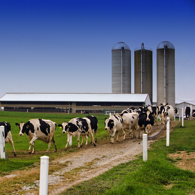Evaluation of microclimate in dairy farms using different model typologies in computational fluid dynamics analyses

Published: 9 July 2024
Abstract Views: 146
PDF: 85
Publisher's note
All claims expressed in this article are solely those of the authors and do not necessarily represent those of their affiliated organizations, or those of the publisher, the editors and the reviewers. Any product that may be evaluated in this article or claim that may be made by its manufacturer is not guaranteed or endorsed by the publisher.
All claims expressed in this article are solely those of the authors and do not necessarily represent those of their affiliated organizations, or those of the publisher, the editors and the reviewers. Any product that may be evaluated in this article or claim that may be made by its manufacturer is not guaranteed or endorsed by the publisher.
Similar Articles
- Andrea Petroselli, Ettore Arcangeletti, Elena Allegrini, Nunzio Romano, Salvatore Grimaldi, The influence of the net rainfall mixed Curve Number – Green Ampt procedure in flood hazard mapping: a case study in Central Italy , Journal of Agricultural Engineering: Vol. 44 No. s2 (2013): Proceedings of the 10th Conference of the Italian Society of Agricultural Engineering
- V. Rondelli, R. Martelli, C. Casazza, A. Guarnieri, Methodological approach to assess tractor stability in normal operation in field using a commercial warning device , Journal of Agricultural Engineering: Vol. 44 No. s2 (2013): Proceedings of the 10th Conference of the Italian Society of Agricultural Engineering
- Nnaemeka R. Nwakuba, Optimisation of energy consumption of a solar-electric dryer during hot air drying of tomato slices , Journal of Agricultural Engineering: Vol. 50 No. 3 (2019)
- Meng Junjie, Cao Ziang, Guo Dandan, Wang Yuwei, Zhang Dashan, Liu Bingyou, Hou Wenhui, Grape detection in natural environment based on improved YOLOv8 network , Journal of Agricultural Engineering: Early Access
- Daniele Duca, Giuseppe Toscano, Ester Foppa Pedretti, Giovanni Riva, Sustainability of sunflower cultivation for biodiesel production in central Italy according to the Renewable Energy Directive methodology , Journal of Agricultural Engineering: Vol. 44 No. 4 (2013)
- R. Sausserde, A. Adamovics, Industrial hemp for biomass production , Journal of Agricultural Engineering: Vol. 44 No. s2 (2013): Proceedings of the 10th Conference of the Italian Society of Agricultural Engineering
- Alessandro Toccolini, Simone Felisari, Paolo Stefano Ferrario, Design of green spaces located below the urbanised level. Themes, problems and solutions applied to a case study , Journal of Agricultural Engineering: Vol. 46 No. 4 (2015)
- Salvatore Margiotta, TECHNICAL CHARACTERIZATION OF ECO-COMPATIBLE PLASTIC FILMS FOR SOIL SOLARIZATION: FOUR YEARS OF EXPERIMENTS , Journal of Agricultural Engineering: Vol. 38 No. 4 (2007)
- Yane Ansanay, Praveen Kolar, Ratna Sharma-Shivappa, Jay Cheng, Sunkyu Park, Consuelo Arellano, Pre-treatment of biomasses using magnetised sulfonic acid catalysts , Journal of Agricultural Engineering: Vol. 48 No. 2 (2017)
- Alessandro Comegna, Antonio Coppola, Giovanna Dragonetti, Time domain reflectometry for dielectric characterization of olive mill wastewater contaminated soils , Journal of Agricultural Engineering: Vol. 51 No. 4 (2020)
<< < 38 39 40 41 42 43 44 45 46 47 > >>
You may also start an advanced similarity search for this article.

 https://doi.org/10.4081/jae.2024.1589
https://doi.org/10.4081/jae.2024.1589







